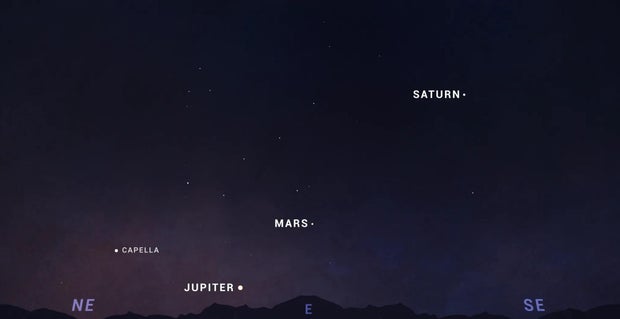You may have heard about a “parade of planets” which was set to grace the Monday morning skies with a rare celestial event. But if you missed it, don’t worry — experts say you’ve been fooled and there will soon be another time to get a better look at a planetary schedule.
Talk of the June 3 “parade of planets” appeared to originate from a social media post from the space news website “Latest in Space.” In a May 21 post, Latest in Space said that “in a rare event, six planets will align straight line on Monday (June 3), just before sunrise in the northern hemisphere”, claiming that Mercury, Jupiter, Uranus, Mars, Neptune and Saturn “will all be visible”.
Many quickly understood that this meant that all the planets would be visible to the naked eye. But according to experts, no “spectacular celestial events” were scheduled to take place this morning.
According to the space news website Espaço.com, planets simply cannot be seen as disks with the naked eye – even the brightest ones will shine like stars. The definite positioning of the planets this morning also proved problematic for the event, as Mercury and Jupiter “will be very close to the Sun’s position in the sky and will therefore likely be masked by the bright glow of the morning twilight,” the website said. he said. The two planets could be visible with binoculars, but a flat, unobstructed horizon would be needed to see them, the website said.
Uranus is visible to the naked eye, but only in dark, unpolluted skies, but as it was only scheduled to rise about an hour before sunrise this morning, the sky was already too bright to actually see it.
“If you go out around 3:30 or 4 a.m. on a Monday morning, don’t expect to be impressed by seeing a parade of planets,” said Space.com. “What you will likely see is a crescent moon and a bright orange ‘star’ shining to its right (Mars) and further to the right will be another relatively bright ‘star’ shining with a yellowish-white hue (Saturn).”
The site also noted that while seeing such a parade would be rare, the alignment of the planets is not a rare event as they are all in one orbital plane.
NASA also confirmed that Monday morning’s alignment wasn’t all it was cracked up to be.
“In reality, only two of the six planets supposedly on display (Saturn and Mars) will actually be visible,” NASA said. “In early June, Jupiter and Mercury will be at or below the horizon in the morning twilight and will not be visible; Uranus and Neptune are too faint to see without a telescope, especially as the morning sky becomes brighter.”
The closest thing to a “parade of planets” will happen on June 29, NASA said, when Saturn, the Moon, Mars and Jupiter line up in the morning.
NASA/JPL-Caltech
Space.com also noted other planetary programming scheduled for next winter. According to the website, the moon, Saturn, Venus and Jupiter will shine in the early evening sky on January 31, 2025 and/or February 1. Mars will also be visible and “more than six times brighter than it appears.” for us now.”
“Compared to all this, the vaunted “Parade of Planets” on June 3 can best be described with a single word: underwhelming,” the site said.
po noticias
entretenimento ou entreterimento
esporte net vip com br
logos gratis
fernanda lobo
logotipo instagram
escudo flamengo png
























